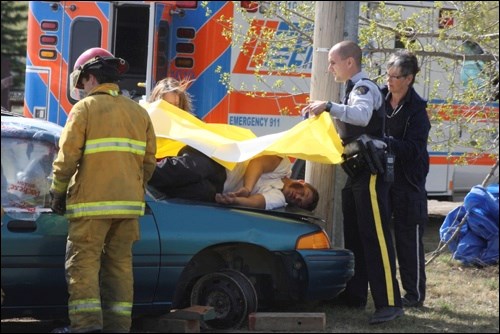There was no sugar-coating the facts at Maidstone High School's SADD event this week.
Along with the school community council, addictions counselling, the RCMP, the physio department, emergency department, Maidstone Health Complex, and Maidstone Ambulance and Maidstone Fire and Rescue they offered the PARTY program to all grade 9 and 10 students. PARTY stands for Prevent Alcohol and Risk-Related Trauma in Youth.
The day began with a presentation of statistics and stories by Julie Gerwing, the education and prevention co-ordinator of the Acquired Brain Injury Outreach Team based at City Hospital in Saskatoon. She shared experiences of working with people with preventable injuries whose greatest wishes were to go back to a moment when they made a simple decision that changed their lives forever.
Gerwing explained the PARTY program is geared toward Grade 9 and 10 students because even though they haven't reached the legal drinking age they are beginning to go to parties, they are learning to drive and they are part of the age group most likely to be injured or killed in a motor vehicle accident.
She told students the cost of injury in Canada is $19.8 billion per year and that 90 per cent of injuries are preventable.
"EMS and RCMP are going to crash after crash where the injuries are preventable. It must be so frustrating," said Gerwing.
She defined an accident as an "act of fate" asking students if they thought the crash caused by a drunk driver in a short video was an accident.
"You know if you drink and drive you have the potential to kill someone. You may think it won't happen to me, but it does happen."
Students witnessed a mock crash with Grade 12 students playing the group of friends who hit a power pole after partying. One of the students spent the entire time motionless on the hood of the car his feet sticking through the windshield. He was covered with a tarp, a grim reminder that young people do die.
Real emergency personnel went through the motions of an actual crash responding to the call, checking and caring for the young people, using hydraulic tools to cut the car apart and going through the arrest process.
After the demonstration was complete a police officer and the chief of the fire department spent a few minutes talking to the students.
"When you go to bed you hear the sounds of the equipment, you smell the smells. I've seen some nasty stuff, I remember the colour of the clothes people were wearing. Why do we so it if it is so traumatic? Somebody has to," said Murray Lundquist of Maidstone Fire and Rescue.
"Please don't drink and drive. If you won't do it for family and friends, do it for us so we don't have to deal with it."
RCMP Constable Conroy Fillion asked the students to think of the parents of the people who are killed in situations like the mock crash.
"We'd have to go to the mom and dad and tell them their 18- or 19-year-old son is dead. It is probably the hardest part of our job," he said.
The young woman who was extracted from the car with mock injuries was taken to the hospital where the students were taken into the emergency room to see what happens when the doctors, nurses and lab personnel take over from the EMS workers.
Students took a look at the physiotherapy department and met a young man who survived a crash and now lives a completely different life in a wheelchair.
Other presentations included an RCMP PowerPoint presentation of photographs and videos from the scenes of fatal preventable collisions including those where people used seatbelts improperly or not at all.
At lunch time the participants had to eat under challenging circumstances. One group had to pretend they were blinded and their hearing was impaired in a crash using cotton balls and blindfolds. Another group's hands were bound so they couldn't use their fingers and thumbs. The third group had to rely on other people to feed and take care of them not using any of their limbs during the meal.
The PARTY program was developed in 1986 in Toronto and now has over 70 programs across the country as well as several internationally. Maidstone's SADD group generally does a big event every year before May long weekend, reminding students and everyone else to make good decisions on the road.



